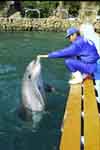 In Taiji Town's new Whale Museum, visitors
can enjoy interacting with dolphins. Dolphins belong to
the whale family but are shorter than whales, usually
being under 4 meters in length whereas whales are more
often 4 meters or longer. At the Whale Museum you can
also find a marinarium and a pool for sea otters.
In Taiji Town's new Whale Museum, visitors
can enjoy interacting with dolphins. Dolphins belong to
the whale family but are shorter than whales, usually
being under 4 meters in length whereas whales are more
often 4 meters or longer. At the Whale Museum you can
also find a marinarium and a pool for sea otters. to the top
 There is a show pool made in a natural cove
where you can interact with Orcas, dolphins, whales and
sea lions. Recently, a program for swimming with the
dolphins was started by a local company. As a therapeutic
measure for depression, autism, and other psychological
problems, swimming with dolphins has become increasingly
popular in the last ten years.
There is a show pool made in a natural cove
where you can interact with Orcas, dolphins, whales and
sea lions. Recently, a program for swimming with the
dolphins was started by a local company. As a therapeutic
measure for depression, autism, and other psychological
problems, swimming with dolphins has become increasingly
popular in the last ten years. to the top
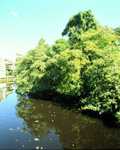 Ukijima no Mori (floating island forest ) is so
named because the whole island is floating on the gas
produced by several layers of decaying plants. The island
features a fragile and beautiful ecosystem featuring
plant species from several different climate zones due to
the heat generated by the methane gas below the island.
More than 100 kinds of plants flourish on the island
including some rare ferns. This place is designated as a
National Natural Treasure. A promenade has been built so
that the floating feeling of Ukijima can be experienced.
In ancient times people kept a distance from the island
because it was believed to be a sacred place.
Ukijima no Mori (floating island forest ) is so
named because the whole island is floating on the gas
produced by several layers of decaying plants. The island
features a fragile and beautiful ecosystem featuring
plant species from several different climate zones due to
the heat generated by the methane gas below the island.
More than 100 kinds of plants flourish on the island
including some rare ferns. This place is designated as a
National Natural Treasure. A promenade has been built so
that the floating feeling of Ukijima can be experienced.
In ancient times people kept a distance from the island
because it was believed to be a sacred place. to the top
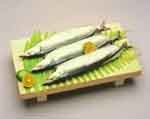 This is one of the local specialties of Kumano
which you find anywhere within the Kumano Field Museum.
The Black Current, a warm sea current which flows from
the East China Sea and passes Kumano, has provided Kumano
with much natural and cultural abundance. One of the
natural graces of the Black Current is the presence of
the Pacific Saury. When the Pacific Saury migrate south
in late autumn to the seas around Kumano they lose much
of their fat and are not so suitable for grilling. The
locals therefore came up with some other delicious ways
to cook Saury. Sanma Zushi is one of the ways in which
Saury is prepared. They open the back of the fish and
stuff vinegared rice into it. This simple invention
helped to enrich the diet of the mountain people who were
deprived of fresh fish and was a welcome addition to the
local fare of the coastal people as well.
This is one of the local specialties of Kumano
which you find anywhere within the Kumano Field Museum.
The Black Current, a warm sea current which flows from
the East China Sea and passes Kumano, has provided Kumano
with much natural and cultural abundance. One of the
natural graces of the Black Current is the presence of
the Pacific Saury. When the Pacific Saury migrate south
in late autumn to the seas around Kumano they lose much
of their fat and are not so suitable for grilling. The
locals therefore came up with some other delicious ways
to cook Saury. Sanma Zushi is one of the ways in which
Saury is prepared. They open the back of the fish and
stuff vinegared rice into it. This simple invention
helped to enrich the diet of the mountain people who were
deprived of fresh fish and was a welcome addition to the
local fare of the coastal people as well. to the top
 Whereas Sanma zushi (Saury sushi) is from the
sea, 'Mehari zushi' is a sushi specialty which has grown
out of the regional mountain culture. Rice is wrapped up
in a sheet of pickled vegetable leaf called takana. This
style of sushi originated from the need for an easy
box-lunch for those who went off into the mountains to
work in the forest industry. Originally it was as big as
a soft ball. So, when people ate one, they had to open
their eyes wide ('mehari'). Hence the name 'Mehari
Zushi'. It has become smaller over the years but its
simple flavour remains and is never boring. It is a
perfect lunch for modern day pilgrims walking on the
Kumano Kodo Old Road.
Whereas Sanma zushi (Saury sushi) is from the
sea, 'Mehari zushi' is a sushi specialty which has grown
out of the regional mountain culture. Rice is wrapped up
in a sheet of pickled vegetable leaf called takana. This
style of sushi originated from the need for an easy
box-lunch for those who went off into the mountains to
work in the forest industry. Originally it was as big as
a soft ball. So, when people ate one, they had to open
their eyes wide ('mehari'). Hence the name 'Mehari
Zushi'. It has become smaller over the years but its
simple flavour remains and is never boring. It is a
perfect lunch for modern day pilgrims walking on the
Kumano Kodo Old Road. to the top
 Another specialty food of the Kumano region is
'Nare Zushi', a kind of fermented sushi. Nare Zushi is
made with both ayu (sweetfish) and sanma (saury). Both
are said to be quite delicious. Edomae sushi for which su
(vinegar) is used, also has its roots in this form of
sushi. Ayu no nare zushi changes its taste and form
according to the duration of fermentation. One
long-established store in Shingu City carries 30 year-old
nare zushi, which is more like yogurt than sushi, a
little too much for beginners. For your first experience
maybe you should first try 'haya nare' which is only 7-10
days old.
Another specialty food of the Kumano region is
'Nare Zushi', a kind of fermented sushi. Nare Zushi is
made with both ayu (sweetfish) and sanma (saury). Both
are said to be quite delicious. Edomae sushi for which su
(vinegar) is used, also has its roots in this form of
sushi. Ayu no nare zushi changes its taste and form
according to the duration of fermentation. One
long-established store in Shingu City carries 30 year-old
nare zushi, which is more like yogurt than sushi, a
little too much for beginners. For your first experience
maybe you should first try 'haya nare' which is only 7-10
days old. to the top
 While kayaking or canoeing in Kumano, you can
take in the mountain views and absorb yourself in the
sound of the wind on the river. Kumano River is perfect
for canoeing because unlike most rivers in Japan, there
are no obstacles like dams or concrete embankments all
the way from Dorokyou Gorge to where the river empties
into the Pacific. Kumanogawa Town is seriously promoting
canoeing as a tourist attraction. They hold a canoe/kayak
marathon every summer which attracts almost 300 canoeists
and kayakers from all over Japan.
While kayaking or canoeing in Kumano, you can
take in the mountain views and absorb yourself in the
sound of the wind on the river. Kumano River is perfect
for canoeing because unlike most rivers in Japan, there
are no obstacles like dams or concrete embankments all
the way from Dorokyou Gorge to where the river empties
into the Pacific. Kumanogawa Town is seriously promoting
canoeing as a tourist attraction. They hold a canoe/kayak
marathon every summer which attracts almost 300 canoeists
and kayakers from all over Japan. to the top
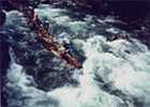 Upstream of the Kumano
River is the Kitayama River, also known as the 。 'River
of the gods'. Before a dam was built on the river in the
1950's rafts were used by local woodsmen to transport cut
timber to market. Now lumber is transported by truck and
rafting down the river has instead become a tourist
attraction. Between May and September the local
government organizes rafting excursions for the public.
The Kitayama River carries the rafters down into the
scarcely explored regions of Yoshino Kumano National
Park.
Upstream of the Kumano
River is the Kitayama River, also known as the 。 'River
of the gods'. Before a dam was built on the river in the
1950's rafts were used by local woodsmen to transport cut
timber to market. Now lumber is transported by truck and
rafting down the river has instead become a tourist
attraction. Between May and September the local
government organizes rafting excursions for the public.
The Kitayama River carries the rafters down into the
scarcely explored regions of Yoshino Kumano National
Park. to the top
 Kumano is also popular as a place for marine
sports enthusiasts with its temperate climate and its
inviting sea waters. Surfing, windsurfing, and scuba
diving are just some of what Kumano has to offer those
who love the water. Kaichu Koen (underwater park) in
Kushimoto attracts a lot of divers. Due to a strong wind
which usually blows off Cape Shionomisaki, Kushimoto is a
great place for wind surfers too. A major wind surfing
race is held here where participants race around the cape
into the open sea.
Kumano is also popular as a place for marine
sports enthusiasts with its temperate climate and its
inviting sea waters. Surfing, windsurfing, and scuba
diving are just some of what Kumano has to offer those
who love the water. Kaichu Koen (underwater park) in
Kushimoto attracts a lot of divers. Due to a strong wind
which usually blows off Cape Shionomisaki, Kushimoto is a
great place for wind surfers too. A major wind surfing
race is held here where participants race around the cape
into the open sea. to the top
 There is a campground which is located along
Ooto River just downstream from Kawayu Onsen Hot spring.
Nestled in the mountains of Kumano you can camp here by
the pristine river and then wander up stream to visit the
outdoor hot spring or simply dig a hole in the riverbed
and make your own private hotspring. This popular
destination is bustling all year round with mostly young
people seeking a reprieve from life in the big cities.
Most come on weekends and holidays to enjoy camping and
soaking in the famous local hot springs. This is perfect
for those who need to let go of a little stress and
refresh themselves.
There is a campground which is located along
Ooto River just downstream from Kawayu Onsen Hot spring.
Nestled in the mountains of Kumano you can camp here by
the pristine river and then wander up stream to visit the
outdoor hot spring or simply dig a hole in the riverbed
and make your own private hotspring. This popular
destination is bustling all year round with mostly young
people seeking a reprieve from life in the big cities.
Most come on weekends and holidays to enjoy camping and
soaking in the famous local hot springs. This is perfect
for those who need to let go of a little stress and
refresh themselves. to the top
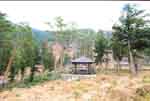 'The 21st Century Forest', which lies near the
foot of Mt.Tamaki, is a new symbol of Totsukawa Village,
the largest village in Japan. It is as if the natural
wonders of Kumano were condensed in this one forest.' The 21st Century Forest' has different zones such as
'ecological forest', 'okugake no mori' (the forest of
Mountain Buddhism), 'demonstration forest' which allow
you the opportunity to experience different elements of
the forest and learn something of forestry at the same
time. This is a lovely place to retreat from the concrete
jungle and nourish yourself in the green spaces and come
a little closer into touch with the earth.
'The 21st Century Forest', which lies near the
foot of Mt.Tamaki, is a new symbol of Totsukawa Village,
the largest village in Japan. It is as if the natural
wonders of Kumano were condensed in this one forest.' The 21st Century Forest' has different zones such as
'ecological forest', 'okugake no mori' (the forest of
Mountain Buddhism), 'demonstration forest' which allow
you the opportunity to experience different elements of
the forest and learn something of forestry at the same
time. This is a lovely place to retreat from the concrete
jungle and nourish yourself in the green spaces and come
a little closer into touch with the earth. to the top